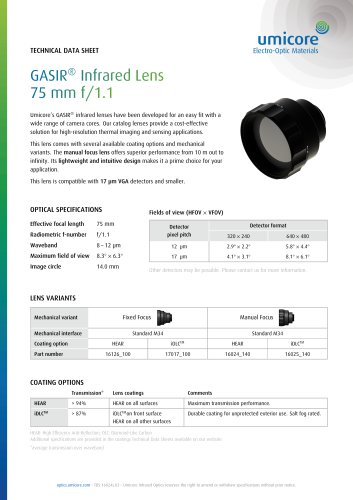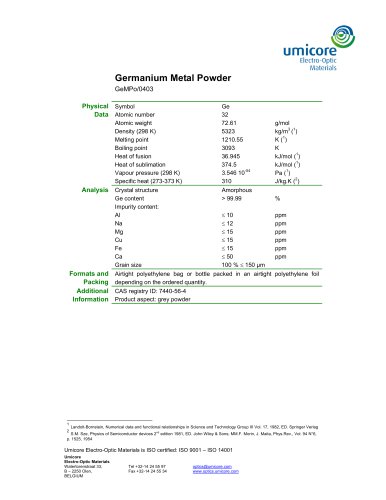
Catalog excerpts

Germanium Optics Leading the way in infrared optics
Open the catalog to page 1
Germanium Infrared Optical Materials Umicore brings you the proven advantages of Germanium (Ge) infrared optical materials for the manufacture of quality thermal imaging systems. Ge provides the reliability and reproducible properties essential to today’s rapidly expanding base of commercial and military thermal imaging applications. Umicore has built upon the many proven advantages of Ge to offer you, the highest quality, the broadest possible range of sizes and specifications and the shortest lead time in the industry. Ge is the material of choice for systems operating in the far infrared...
Open the catalog to page 2
Umicore Germanium Optics 3 Properties of Germanium Physical Symbol Ge Atomic Number 32 Atomic Weight 72.59 Crystal Structure diamond cubic 5.323 Density, 25°C, (g/cm3) 4.416 X 1022 Atomic Density, 25°C, (atoms/cm3) Lattice Constant, 25°C,(nm) 0.565754 Surface Tension, liquid at mp, (mN/m, (= dyne/cm)) 650 Modulus of Rupture, (MPa) 72.4 Mohs Hardness 6.3 Vickers Hardness, 25 gm load, (kg/mm ) 746 (53 ohm-cm) Other Resistivities (See Figure Below) 1.004 (110 fracture plane) Fracture Toughness, (MPa•m1/2) Thermal Shock Resistance 125°C Poisson’s Ratio, 125-375 K 0.278 Natural Isotopic...
Open the catalog to page 3
Strength The thickness required to support a pressure difference may be determined by the following equation: Thk = (1.1 P r2 SF/MR)1/2 where P= pressure difference (PSI) r= unsupported radius (inches) SF= safety factor (4 to 6 suggested) MR= modulus of rupture (PSI) Chemical Properties Germanium is quite stable in air up to 400°C when slow oxidation begins. Oxidation becomes noticeably more rapid above 600°C. The metal resists concentrated hydrochloric acid, concentrated hydrofluoric acid and concentrated sodium hydroxide solution, even Properties of Standard Opical Grade Germanium at...
Open the catalog to page 4
Umicore Germanium Optics 5 Guaranteed Minimum Transmission and Maximum Absorption Coefficients of Standard Optical Grade Ge at 25°C Wavelength (urn) Theoretical Minimum Maximum Maximum Transmission Absorption Based upon the refractive index and absorption coefficient of typical Optical Grade Germanium, the total energy distribution of a light beam approaching a Germanium flat at normal incidence can be calculated at any wavelength according to the following T = fraction of energy transmitted R = fraction of energy reflected A = fraction of energy absorbed Energy Distribution of Typical...
Open the catalog to page 5
Index of Refraction at 25°C of Optical Grade Germanium 7 One of the most important properties of Germanium is its high refractive index, making it a very useful imaging component of IR systems operating in the 2 to 12 µm range. Although we do not measure the See expanded view below Umicore’s Optical Grade Germanium has been found to have inhomogeneities of the index below 2 X 10-4. The transmission curve at the top of the next page shows the typical transmission index of refraction nor its homogeneity, 4 of Optical Grade Ge at 25°C for a polished, uncoated sample of 10 mm thickness.
Open the catalog to page 6
Umicore Germanium Optics 7 Germanium Typical Transmission Germanium Typical Transmission Absorption at 25°C of Optical Grade Germanium Typical Germanium Coefficient of Absorption Typical Germanium Coefficient of Absorption 3 2 Absorption Coefficient )(cm-1) Abs Coeff. (cm-1 Germanium exhibits low absorption of infrared radiation in the usable wavelength range of 2 to 12 µm. The band gap of 0.67 eV in Germanium is responsible for the increase in absorption in the short wavelength region. The lattice (phonon) absorption bands are responsible for the long wavelength absorption. The absorption...
Open the catalog to page 7
Absorption vs. Temperature10.610.6 µm Absorption vs. Temp at at μ At high temperatures, Standard Optical Grade Germanium is subject to excessive absorption due to the increased number of thermally generated holes. Germanium can be optimized for use at 80°C or higher by special doping to lower n-type resistivities. This special doping makes it possible to optimize the transmission of Ge for other than standard optical conditions, with minimal losses when operating at standard conditions.
Open the catalog to page 8
Umicore Germanium Optics 9 Absorption vs. Temperature10.68.0 µm Absorption vs. Temp at at µ
Open the catalog to page 9
-1 Absorption Coefficient at 10.6at 10.6 µm Abs Coeff (cm-1) (cm ) µm 10 Resistivity (ohm-cm) at 25°C Resistivity (ohm-cm) at 25 C Free carrier (electron and hole) absorption and lattice (phonon) absorption account for the IR absorption in the optical range. Holes in Ge absorb more IR energy than electrons in this range. For nearly electrically neutral Ge, the number of holes times the number of electrons is constant. The number of holes present can be reduced by increasing the number of electrons by the addition of group V atoms (donors) to the Ge. This lowers the resistivity. Excessive...
Open the catalog to page 10
Umicore Germanium Optics 11 Abs Coeff (cm-1) (cm-1) µm Absorption Coefficient at 10.6at 8.0 µm A special grade of Ge, called EMI for its ability to shield against electromagnetic interference, has become increasingly important for modern defence applications where other signals can be strong enough to make nearby IR systems ineffective. By providing a Ge window with a lower resistivity, these signals are effectively shorted out, and the IR system functions without difficulty. Ge at EMI resistivities will have a minimal increase in absorption compared to Standard Optical Grade Ge.
Open the catalog to page 11
Ge windows can also be electrically heated, for anti-icing and anti-fogging purposes, allowing the customer to add options of window resistance and power dissipation specifications. Resistivity versus Temperature for n-type Ge of different dopant densities Intrinsic Resistivity (ohm-cm) Resistivity (ohm-cm)
Open the catalog to page 12
Umicore Germanium Optics 13 % Transmission (0.5 cm thickness) % Transmission (0.5 cm thickness) The far IR transmission (20 to 160 µm) of a polished, uncoated sample of n-type Ge of different resistivities 0.5 cm thick at 24°C is shown above. Data not shown indicate the transmission at elevated temperatures (about 100°C) is nearly the same (and less than 5%) regardless of the resistivity of the material. There is a minimal increase in transmission at lower temperatures.
Open the catalog to page 13All Umicore Electronic Materials catalogs and technical brochures
-
GASIR®1 material
2 Pages
-
50 mm f/1.0
2 Pages
-
1.9 mm f/1.3 M10
2 Pages
-
Germanium Ingots
1 Pages
-
Germanium Granules
1 Pages
-
Germanium Metal Powder
1 Pages
-
Filters: long-wave pass
1 Pages
-
Filters: wide bandpass
1 Pages
-
Filters: Short-Wave Pass
1 Pages
-
Filters: narrow bandpass
1 Pages
-
iDLC coating
1 Pages
-
Umicore brochure
16 Pages




















































